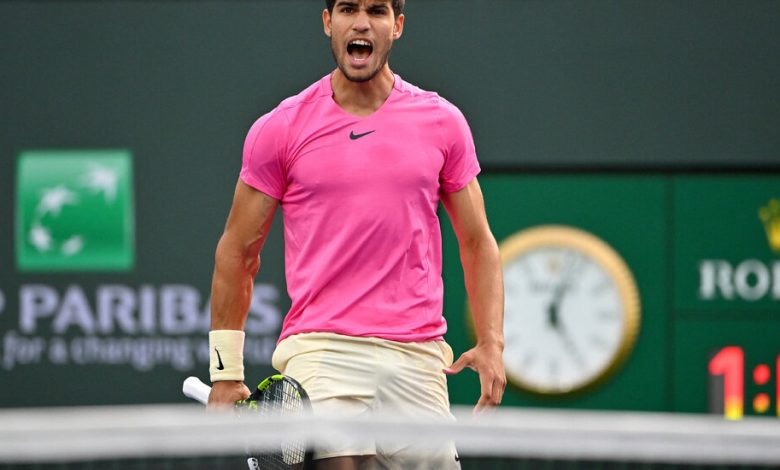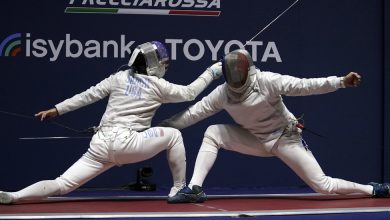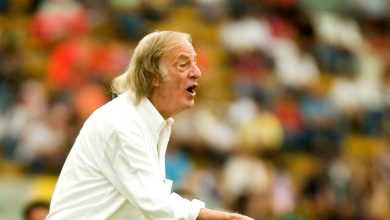Here Comes Carlos Alcaraz Again. Next Stop: Miami.

INDIAN WELLS, Calif. — The sun was setting in the desert, and dark clouds were gathering, but Carlos Alcaraz was walking jauntily down a hallway in Stadium 1 at the BNP Paribas Open.
He had finished ahead of the storm and everything else on his way to the trophy in Indian Wells, securing the title without losing a set, not even against Daniil Medvedev, the hottest hand in tennis, in an unexpectedly lopsided final on Sunday.
His 6-3, 6-2 victory — full of exquisitely disguised drop shots, lunging volley winners and other dazzle — did not only stop Medvedev’s 19-match winning streak in a hurry. It also earned Alcaraz a return to the No. 1 singles ranking on Monday, displacing Novak Djokovic, the Serb who is not allowed to enter the United States because he remains unvaccinated for the coronavirus.
Djokovic, a five-time singles champion in Indian Wells, is the most successful men’s hardcourt player in tour history. But his decision to forgo vaccination has caused him to miss a string of significant events, including last year’s U.S. Open, which Alcaraz, a Spaniard, won to ascend to the top spot in the rankings for the first time at age 19.
“Look, the truth is I’m a player, but I’m also a fan of tennis,” Alcaraz said in an interview on Sunday. “And in the end, having the best players in each tournament and being able to compete with the best is always good. Nobody wants to see people missing tournaments, especially me. I wish Djokovic were in every event and I could play against him and share the locker room with him and learn from him up close.”
It is the tennis duel that many would most like to see, and it did not happen in January at the Australian Open, which Djokovic won for the 10th time. Alcaraz missed it because of a leg injury incurred after lunging for a shot in practice shortly before he was scheduled to leave Spain for Australia. He had already missed the end of the 2022 season because of a torn stomach muscle.
“That was rough: to miss Australia, a Grand Slam I really wanted to play and thought I would have my chances to win,” Alcaraz said. “But it made me learn from the things I wasn’t doing right. You can be on court for two or three hours a day, but it’s also about how you take care of yourself outside the court: to rest, eat well, take the right supplements.”
While the leading men have yet to all gather in the same spot this season, the leading women reunited in the desert and produced a repeat of the high-velocity Australian Open final between the 6-foot power players Aryna Sabalenka of Belarus and Elena Rybakina of Kazakhstan by way of Moscow.
While Sabalenka won in a three-set classic in Melbourne, Rybakina prevailed on Sunday, 7-6 (11), 6-4, saving two set points in a nervy opening set that had even the self-contained Rybakina struggling to keep a poker face.
Sabalenka’s stumbling block was a familiar one: double faults. They spoiled much of her early 2022 season, but she worked her way through the problem with help from a biomechanist and served well under duress in Australia. On Sunday, she regressed, making 10 double faults — all in the first set and three in the tiebreaker — and was clearly unsettled by it.
“There will be some days when old habits will come back, and you just have to work through it,” she said of what she had learned from the defeat.
Rybakina, the reigning Wimbledon champion who is now No. 7 in the rankings, has beaten the No. 1, Iga Swiatek, twice this year, including overwhelming her in the semifinals on Saturday.
For now, Alcaraz and Djokovic have played each other just once, with Alcaraz winning on clay in three tight sets on his way to the title in Madrid last May. It is hardly Alcaraz’s fault that they missed each other here in the desert even if it is, to some degree, his problem because he is back at No. 1 under unusual circumstances. Djokovic received no ranking points for winning Wimbledon last year after the tours stripped the venerable tournament of points because of its ban on Russian and Belarusian players, including Medvedev.
But Medvedev, after being drubbed on Sunday, said that Alcaraz had earned the top spot and that there should be “no buts” even if the rankings might have been different had Djokovic been able to play a full schedule.
“Carlos is deservedly world No. 1,” he said. “He won more points than everybody else in the last 52 weeks, and that’s how rankings work.”
Monday also brought bad news for Spanish tennis with Rafael Nadal dropping out of the top 10 for the first time since April 25, 2005, ending a record streak of nearly 18 years. It is hard to imagine Alcaraz or anyone else matching that kind of consistency, but Alcaraz is clearly an incandescent talent: an acrobat in sneakers capable of dominating and mesmerizing.
That is a rare combination reminiscent of Roger Federer, the 20-time Grand Slam champion and serial crowd pleaser whose photo was once in Alcaraz’s bedroom at his family’s home in Murcia, Spain. Like Federer, who retired last year at 41, Alcaraz is a fabulous and feline mover who likes variety and the element of surprise with his abrupt changes of pace and fast-twitch forays to the net.
“I think he’s a lot more like Roger than Rafa,” said Paul Annacone, a Tennis Channel analyst who coached Federer. “Because Rafa couldn’t take the ball early like this when he was 19, and Rafa couldn’t come forward like this. Roger could always stay on the baseline and always look like he had time, and that’s how this kid looks.”
Neither Federer nor Nadal (nor Djokovic) was No. 1 as a teenager. For Annacone, Alcaraz is “the most complete 19-year-old men’s player” in memory, with consistency and decision-making not typically seen in young players.
“The interesting thing for me is watching someone who is this athletically talented with his running, jumping, explosiveness and flexibility, but also has the hand-eye coordination to be able to take the ball early on the rise, come forward and volley,” Annacone said. “He also can back up and change pace. He can do everything.”
Medvedev certainly looked outmanned on this blustery Sunday: unusually erratic from the baseline and often late to react to Alcaraz’s tactical shifts and to his bold returns from inside the court.
Alcaraz served and volleyed effectively but also beat Medvedev at his own game — baseline tennis — with his powerful groundstrokes and deft touch (he hit three straight forehand drop shot winners late in the match).
Though doubts remain about his staying power, it has been a convincing comeback. Last month, Alcaraz won on clay in Buenos Aires, then reached the final in Rio de Janeiro, where he reinjured his leg in a loss to Cameron Norrie. But after a few days of rest and therapy, he looked as nimble as ever in Indian Wells.
Next stop in this sunshine swing on American hardcourts: the Miami Open, which begins on Friday and where Alcaraz will need to successfully defend his title to keep Djokovic, still in absentia, from reclaiming the No. 1 spot.
Their rematch will have to wait for the European clay-court season and hopefully no later than that.




